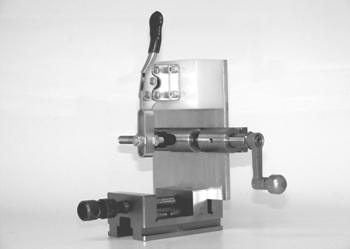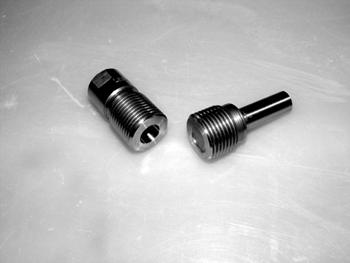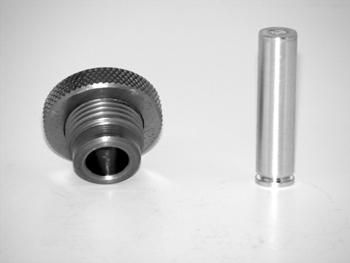Brass Preparation And Management
Resized .243 range brass was used in trial cuts to get the proper dimension on the case neck. Using a spud the size of the selected bullet allows a direct measurement of the neck with no need to use a ball micrometer and math. At this point, I stopped cutting and ran the lathe at 1000 RPM for one hour to temperature stabilize the machine. When the lathe was up to temperature, the trial cut was repeated and measured. When I was satisfied with the neck diameter, the cross slide was locked. One more scrap case was cut to make sure that nothing had moved. All turning was done at 1000 RPM. When making this cut a small oil bottle with a 1.5" syringe needle was used to apply oil to the neck during the cut. These polyethylene bottles hold two ounces of fluid and are dandy for oil application in tight areas. The bottle cap has a Luer spout that accepts syringe needles. The bottles and needles are available from MSC (Mscdirect.com) and Small Parts (Smallparts.com). Small Parts carries a large variety of needles. There is not a doubt in my mind that I will someday stab the crap (this is a high level medical term) out of myself with one of these oil bottles. With this type of oil application I used less than one ounce of oil on the full number of cases. Running the lathe coolant would have made a big mess.
In operation the cutter is fed slowly over the case neck to the shoulder-neck junction and then fed slowly back off of the neck. The oil bottle was held in my right hand resting on the toolpost and the carriage was moved with my left hand. Before stopping the spindle the case neck and shoulder was wiped off with a Q-Tip. With the spindle stopped the case holder is dropped onto the case head and into the tailstock adapter. As previously mentioned the tailstock wheel may need a jiggle to accomplish this task. The case is then withdrawn from the spud. I checked every case with a ball micrometer in three different places as they came off the lathe. This did not take long and was a 100 percent QC check. I am sure that this was overkill but I wanted to know that nothing was changing (with a fully warmed up machine change was unlikely).
I turned just under three hundred cases on the lathe over two evenings. My average time was forty to forty five cases per hour (checking every case with the micrometer) with no rejects. The best time I could make on the cases done with a hand tool (also checking with a micrometer) was twenty cases per hour. The difference in time was caused by the spindle speed. I should say here that my lathe has a clutch and brake system for the spindle. This ability to avoid powering the motor up and down between cuts gives this machine a little time edge compared to a smaller shop lathe. The run-out accuracy was the same with both methods of neck turning.
For small batches, a preset hand tool would probably be the way to go. The above time results indicate that I would be better off using the lathe for turning any large amount of case necks.

Wilson trimming fixture shown in the desired position for trimming. This vertical position allows the chips to fall to the floor. When actually cutting, the fixture would be held in a bench vise.
A further aid in case preparation efficiency (at least for me) is a simple modification to the Wilson case trimmer. I like this trimmer better than any other that I have used to date. The only two things I didn't like about the trimmer was having to press the case holder against the ways while turning the cutter handle and having the brass chips fall all over the ways. These two problems turned out to be easy to fix. To keep the case holder pinned to the ways; the Wilson trimmer was screwed to a plate together with a hold-down toggle clamp. The clamp has a rubber nose that contacts the Wilson case holder and keeps it firmly in place. In use the fixture plate is held vertically in a bench vise allowing the brass chips to fall to the floor. This fixture was made of aluminum and plastic because my shop is full of those materials. Two by four lumber would work just as well as the fixture block needs about 1.5" of height to position the clamp correctly. The clamp is MSC part number 66759010 and is low cost. At a shoot, this fixture can be used in the horizontal position on some rubber shelf liner to keep it from scooting around while cranking the handle.

Lee full-length 22/250 sizing die cut apart to make a ring die. .006" undersize gage pin is shown inserted to find the cut off point.
The last item in this article is a ring die. The late Phil Sauer (who was a really smart man) described this tool some years back in Precision Shooting. I don't recall reading any mention of the ring die since. The ring die is more of a salvage tool than a preparation tool. The tool is tapered inside down to a dimension that will swage the case web area back to original (or desired) diameter. No full length-sizing die I have used to date will effectively size the web area of the case. I have two 6PPC reamers that are of a slightly different diameter in that case web area. I now use only one of these reamers (both reamers are excellent) to allow case interchange between barrels. Having over sixty good cases fired in the larger chamber started me thinking of an easy way to make a ring die so those cases could be swaged back to a useable size.

Ring die is shown on the left. A piece of 7075 hard aluminum was turned down to make a rod for driving the lubricated 6PPC case completely through the sizing die.
For whatever reason, I have an almost obsessive interest in case design. I noticed while perusing the case dimensions in various loading manuals that the 22/250 case has a good deal of body taper - enough taper to function as a ring die. I purchased a Lee RGB die set for the full-length size die. I guessed that a constriction of at least .003" would be necessary to swage down the base area of the case. Pin gages were used to find the place in the die interior where the diameter was .006" under case web size. The size die was then cut off at that place in the lathe using a carbide cut off tool. The cut off die base was then held in the lathe chuck with the base toward the tailstock and the interior of the die lapped out at low RPM. This operation was done with the lap held in the tailstock chuck using the handwheel to run the lap in and out. I used a seven-sixteenths adjustable barrel lap (MSC #05060280) with 240-grit silicon carbide abrasive paste. As lapping proceeds, it is a good idea to take the ring die out, clean out the abrasive, and run a test case through the die. The web area of the case springs back after sizing and the amount of spring back is affected by the hardness of the brass. The measurement of the test case is a good indicator of how much more lapping is necessary. A light polish with crocus cloth (wrapped around a wooden dowel) will slick up the inside of the die without changing dimensions very much.
This work was an interesting exercise for me. Until I did this large amount of cases I had no real idea what time was needed per piece and which turning method was best. Turns out that both methods work pretty good.
In operation the cutter is fed slowly over the case neck to the shoulder-neck junction and then fed slowly back off of the neck. The oil bottle was held in my right hand resting on the toolpost and the carriage was moved with my left hand. Before stopping the spindle the case neck and shoulder was wiped off with a Q-Tip. With the spindle stopped the case holder is dropped onto the case head and into the tailstock adapter. As previously mentioned the tailstock wheel may need a jiggle to accomplish this task. The case is then withdrawn from the spud. I checked every case with a ball micrometer in three different places as they came off the lathe. This did not take long and was a 100 percent QC check. I am sure that this was overkill but I wanted to know that nothing was changing (with a fully warmed up machine change was unlikely).
I turned just under three hundred cases on the lathe over two evenings. My average time was forty to forty five cases per hour (checking every case with the micrometer) with no rejects. The best time I could make on the cases done with a hand tool (also checking with a micrometer) was twenty cases per hour. The difference in time was caused by the spindle speed. I should say here that my lathe has a clutch and brake system for the spindle. This ability to avoid powering the motor up and down between cuts gives this machine a little time edge compared to a smaller shop lathe. The run-out accuracy was the same with both methods of neck turning.
For small batches, a preset hand tool would probably be the way to go. The above time results indicate that I would be better off using the lathe for turning any large amount of case necks.

Wilson trimming fixture shown in the desired position for trimming. This vertical position allows the chips to fall to the floor. When actually cutting, the fixture would be held in a bench vise.
A further aid in case preparation efficiency (at least for me) is a simple modification to the Wilson case trimmer. I like this trimmer better than any other that I have used to date. The only two things I didn't like about the trimmer was having to press the case holder against the ways while turning the cutter handle and having the brass chips fall all over the ways. These two problems turned out to be easy to fix. To keep the case holder pinned to the ways; the Wilson trimmer was screwed to a plate together with a hold-down toggle clamp. The clamp has a rubber nose that contacts the Wilson case holder and keeps it firmly in place. In use the fixture plate is held vertically in a bench vise allowing the brass chips to fall to the floor. This fixture was made of aluminum and plastic because my shop is full of those materials. Two by four lumber would work just as well as the fixture block needs about 1.5" of height to position the clamp correctly. The clamp is MSC part number 66759010 and is low cost. At a shoot, this fixture can be used in the horizontal position on some rubber shelf liner to keep it from scooting around while cranking the handle.

Lee full-length 22/250 sizing die cut apart to make a ring die. .006" undersize gage pin is shown inserted to find the cut off point.
The last item in this article is a ring die. The late Phil Sauer (who was a really smart man) described this tool some years back in Precision Shooting. I don't recall reading any mention of the ring die since. The ring die is more of a salvage tool than a preparation tool. The tool is tapered inside down to a dimension that will swage the case web area back to original (or desired) diameter. No full length-sizing die I have used to date will effectively size the web area of the case. I have two 6PPC reamers that are of a slightly different diameter in that case web area. I now use only one of these reamers (both reamers are excellent) to allow case interchange between barrels. Having over sixty good cases fired in the larger chamber started me thinking of an easy way to make a ring die so those cases could be swaged back to a useable size.

Ring die is shown on the left. A piece of 7075 hard aluminum was turned down to make a rod for driving the lubricated 6PPC case completely through the sizing die.
For whatever reason, I have an almost obsessive interest in case design. I noticed while perusing the case dimensions in various loading manuals that the 22/250 case has a good deal of body taper - enough taper to function as a ring die. I purchased a Lee RGB die set for the full-length size die. I guessed that a constriction of at least .003" would be necessary to swage down the base area of the case. Pin gages were used to find the place in the die interior where the diameter was .006" under case web size. The size die was then cut off at that place in the lathe using a carbide cut off tool. The cut off die base was then held in the lathe chuck with the base toward the tailstock and the interior of the die lapped out at low RPM. This operation was done with the lap held in the tailstock chuck using the handwheel to run the lap in and out. I used a seven-sixteenths adjustable barrel lap (MSC #05060280) with 240-grit silicon carbide abrasive paste. As lapping proceeds, it is a good idea to take the ring die out, clean out the abrasive, and run a test case through the die. The web area of the case springs back after sizing and the amount of spring back is affected by the hardness of the brass. The measurement of the test case is a good indicator of how much more lapping is necessary. A light polish with crocus cloth (wrapped around a wooden dowel) will slick up the inside of the die without changing dimensions very much.
This work was an interesting exercise for me. Until I did this large amount of cases I had no real idea what time was needed per piece and which turning method was best. Turns out that both methods work pretty good.
